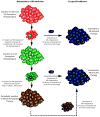Resistance emerges to second-generation antiandrogens in prostate cancer
- PMID: 24019330
- PMCID: PMC3800038
- DOI: 10.1158/2159-8290.CD-13-0405
Resistance emerges to second-generation antiandrogens in prostate cancer
Abstract
The appearance of a mutant androgen receptor, AR(F876L), in prostate cancer cells chronically exposed to enzalutamide or ARN-509 promotes a switch from antagonist to agonist receptor function, undermining the potential long-term effectiveness of these second-generation antiandrogen drugs.
©2013 AACR.
Conflict of interest statement
No potential conflicts of interest were disclosed.
Figures

Comment on
-
A clinically relevant androgen receptor mutation confers resistance to second-generation antiandrogens enzalutamide and ARN-509.Cancer Discov. 2013 Sep;3(9):1020-9. doi: 10.1158/2159-8290.CD-13-0226. Epub 2013 Jun 18. Cancer Discov. 2013. PMID: 23779130
-
An F876L mutation in androgen receptor confers genetic and phenotypic resistance to MDV3100 (enzalutamide).Cancer Discov. 2013 Sep;3(9):1030-43. doi: 10.1158/2159-8290.CD-13-0142. Epub 2013 Jul 10. Cancer Discov. 2013. PMID: 23842682
References
-
- Joseph JD, Lu N, Qian J, Sensintaffar J, Shao G, Brigham D, et al. A clinically relevant androgen receptor mutation confers resistance to 2nd generation anti-androgens enzalutamide and ARN-509. Cancer Discovery. 2013;X:xx–xx. - PubMed
-
- Korpala M, Korna JM, Gaob X, Rakiecc DP, Ruddyc DA, Doshia S, et al. A novel mutation in androgen receptor confers genetic and phenotypic resistance to MDV3100 (enzalutamide) Cancer Discovery. 2013;X:xx–xx. - PubMed
Publication types
MeSH terms
Substances
Grants and funding
LinkOut - more resources
Full Text Sources
Other Literature Sources
Research Materials

